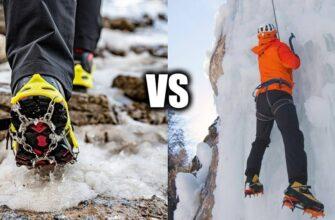Many outdoor enthusiasts often wonder, “Can you use Crocs for hiking?”
You can find here 7+ important tips to help those seeking information on whether or not Crocs are suitable for hiking.
Crocs hiking shoes are not recommended for serious hiking due to their lack of ankle support and traction. While they may be suitable for short and easy hikes, it is advisable to opt for proper hiking footwear that provides stability and protection, especially on uneven terrains. Some hikers prefer traditional hiking boots, but some individuals argue that with the right precautions, it is possible to wear Crocs hiking boots for outdoor adventures.
- Is It a Good Option Hiking in Crocs?
- Factors to Analyze Before Using Crocs for Hiking
- The Weather on The Trail
- Length of The Hike
- Crocs Have Open Holes
- Trail Length
- Hike Terrain
- Pros of Wearing Crocs Hiking
- Disadvantages of Hiking in Crocs
- Not Good on Rough Terrain
- The Low Grip on Ground
- Painful on Sharp Rocks
- Crocs for Backpacking
- How do I Prevent Blisters from Crocs?
- Are Crocs Good for Plantar Fasciitis?
- What Are The Best Crocs for Hiking?
- Trail Crocs
- Crocs Hiker Clog [Hiking Clogs]
- Can You Wear Crocs Barefoot?
- How Much Do Crocs Weigh?
- Are Crocs Good for Creek Walking And River Crossings?
- Are Crocs Good for Walking All Day?
- Are Crocs Good as Camp Shoes?
- Are Crocs Worth it?
- FAQ
- Are Crocs Good for Hiking?
- Can You Wear Crocs on Long Walks?
- Are Crocs Good for Backpacking
- Are Crocs Slippery When wet?
- Final thoughts on hiking in Crocs
Is It a Good Option Hiking in Crocs?
Are you considering wearing Crocs shoes while hiking? While they may be comfortable and quick-drying, it’s important to remember that hiking boots and shoes are specifically designed to meet the requirements of hiking activities. By choosing the appropriate footwear, you’ll not only ensure your safety on the trails but also enhance your overall hiking experience. So, before you hit the trails, keep in mind the importance of choosing the right hiking boots or shoes that meet the specific requirements of hiking activities.

Factors to Analyze Before Using Crocs for Hiking
When it comes to hiking, your safety should always come first. That’s why it’s essential to carefully analyze all factors before hitting the trails in your Crocs.
Remember, taking the time to assess the situation can save you from a world of trouble down the road.
If you’re planning to walk on an unpaved trail, it’s important to consider the practicality of wearing Crocs. Due to their basic design, they may not provide the necessary support and grip needed for such terrain. It’s always better to opt for more suitable footwear in order to avoid any discomfort or slips.
Before considering hiking in Crocs, it is important to understand their limitations and potential hazards. Here are some factors to consider:
The Weather on The Trail
Crocs are not suitable for all weather conditions. If you plan to hike in cold or wet weather, you will need to wear shoes that are waterproof and insulated. Crocs are not designed to keep your feet warm or your feet dry.
First, check whether the trail has dried. The only conditions suitable for hiking Crocs are dry summers. No wearing Crocs as hiking shoes in wet weather or on rainy days. Besides, the croc has very weak steering control over muddy wheat.
Length of The Hike
Nobody could go in Crocs all that long if it wasn’t slowed down. When hiking a 5-mile hike or a longer distance, it might be advisable to not consider using Crocs.
If you are considering going on a brief and effortless stroll, then Crocs could be a suitable option for you. However, if you’re planning on a long hike, Crocs may not provide enough support or protection for your feet, as well as bring foot pain.
Crocs Have Open Holes
Crocs are comfortable with wide holes that allow air through the holes. Despite their excellent service for normal use, wearing Crocs for hiking in rough terrain is not a good idea.
To ensure a safe and enjoyable hiking experience, it is crucial to keep your feet away from sharp and rocky surfaces like stones. These obstacles can quickly turn a fun adventure into a painful and frustrating one. Don’t let discomfort ruin your hike. Keep your feet protected and enjoy the beauty of nature worry-free.
Getting sand under your foot arch can be a frustrating experience, especially when you’re out on a hike like I was on the Appalachian Trail. It can force you to stop and remove your footwear to get rid of the irritating stone.
Hence, the combination of weak ankle support with sweaty feet will make hiking in Crocs uncomfortable.
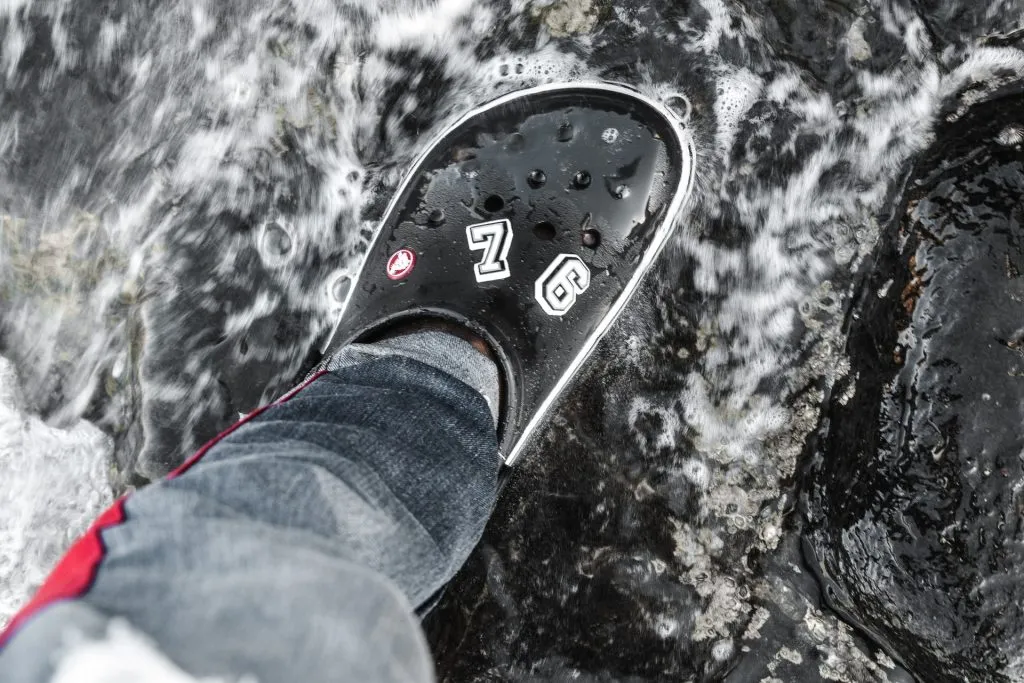
Trail Length
Depends on the duration of the hike. Shorter trails are ideal for wearing Crocs, but once you reach two or three miles, you want something more supportive. Crocs do not go well over long hikes as hiking shoes, so many hikers are aware of it.
Hike Terrain
The terrain of the path is important. Elevation gains can also be considered if you want to use them on unsuitable terrain. This means even a 1- mile trail with rough terrain can make it a tough trail.

Pros of Wearing Crocs Hiking
While Crocs are not typically recommended as hiking boots, there are some potential benefits of wearing them in certain situations, as in general, they are great shoes:
- Lightweight: Crocs are very lightweight, which can be an advantage for hikers who are looking to reduce the weight of their gear.
- Easy to Clean: Crocs are made of a non-porous material that can be easily cleaned with soap and water, which can be useful for hikers who encounter muddy or wet trails.
- Breathable: Crocs have a lot of ventilation holes, which can allow you to avoid sweaty feet and prevent them from overheating, particularly in hot weather.
- Quick-Drying: Crocs can dry quickly, which can be helpful if you encounter water on your hike.
- Versatile: Crocs are versatile shoes that can be worn for a variety of activities, including hiking, swimming, and boating. If you plan on doing a combination of activities on your hiking trip, the Crocs brand might be a convenient option.
It’s important to note, however, that these benefits should be weighed against the potential risks and drawbacks of wearing Crocs for hiking, including thin sole, lack of support, traction, and protection for your feet.
It’s generally recommended that hikers choose footwear specifically designed for hiking to ensure safety and comfort on the trail.
Disadvantages of Hiking in Crocs
If you’re planning a hike, it’s important to choose the right footwear. While flip-flops may seem like a good idea, and Crocs do have some advantages, they’re not the best choice for long-distance hiking. In fact, regular sneakers are a much better option. So, if you want to enjoy your hike without any foot discomfort, it’s best to leave your Crocs at home.
Not Good on Rough Terrain
It’s important to keep in mind that Crocs don’t make the best footwear for mountain climbing. While they may hold up on snow, gravel, and rough terrain, they’re not designed for such a task. For optimal comfort and safety, it’s best to reserve Crocs for flat trails with little elevation gain and no steep inclines. Trust us, your feet will thank you later.
The Low Grip on Ground
Crocs are undoubtedly versatile, and can be worn both indoors and outdoors. However, it’s important to note that they may not provide a strong grip on all surfaces.
Hiking shoes, on the other hand, typically have rubber soles with wedges cut into the bottom for a secure fit. Rubber has excellent traction on most surfaces. In contrast, the EVA sole found in Crocs is filled with rubber and has lower friction, which can make it slippery on wet surfaces. When walking on muddy surfaces, it’s easy to slip or fall when wearing Crocs.
Painful on Sharp Rocks
Crocs are an excellent choice for hiking enthusiasts, especially because of their unique design that prevents rocks or sharp objects from getting inside. With time, Crocs adapt to your foot, providing unparalleled comfort and safety during your treks.
However, if you have soft feet and prefer utmost comfort and safety, it might take some time to get accustomed to Crocs. In such cases, using trekking poles can be helpful to ease the transition process.
Crocs for Backpacking
Choosing the right footwear for backpacking can be a tough decision. While many outdoor enthusiasts overlook Crocs as a viable option, they shouldn’t be dismissed. In fact, Crocs can be the perfect camping shoes for flat surfaces and minimal spaces.
Since Crocs help in keeping your feet cool and provide comfort, almost everyone who goes backpacking has carried them on long journeys and wears them on the campground after a long day due to their lightweight and comfort.
Don’t miss out on the lightweight and comfort benefits that Crocs provide on your next backpacking adventure.
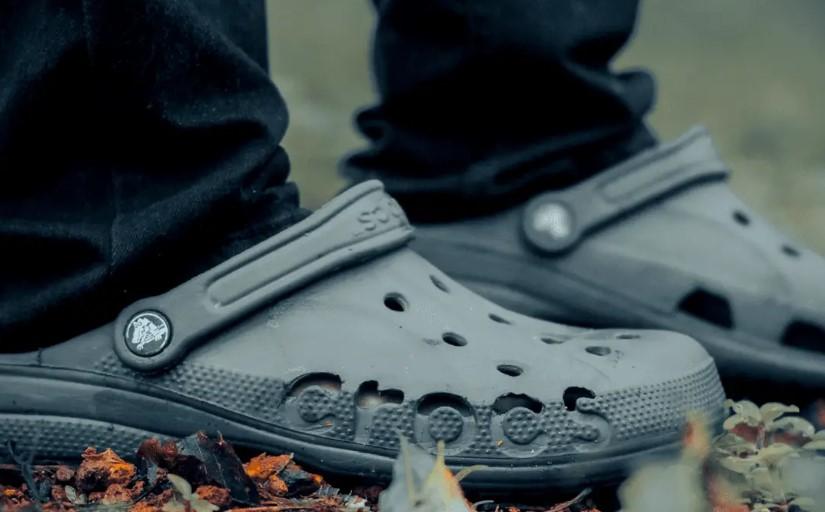
How do I Prevent Blisters from Crocs?
Crocs can cause blisters if they are not fitted properly. If Crocs are too big or too tight, they can rub your feet, causing irritation and blisters.
The most common blister area in Crocs is inside the foot below the ankle, where the strap rubs. Blisters can form between the big and second toe if Crocs are too tight, pressing the toes together.
While wearing socks is the best way to prevent blisters, there are other exciting ways to keep your feet blister-free.
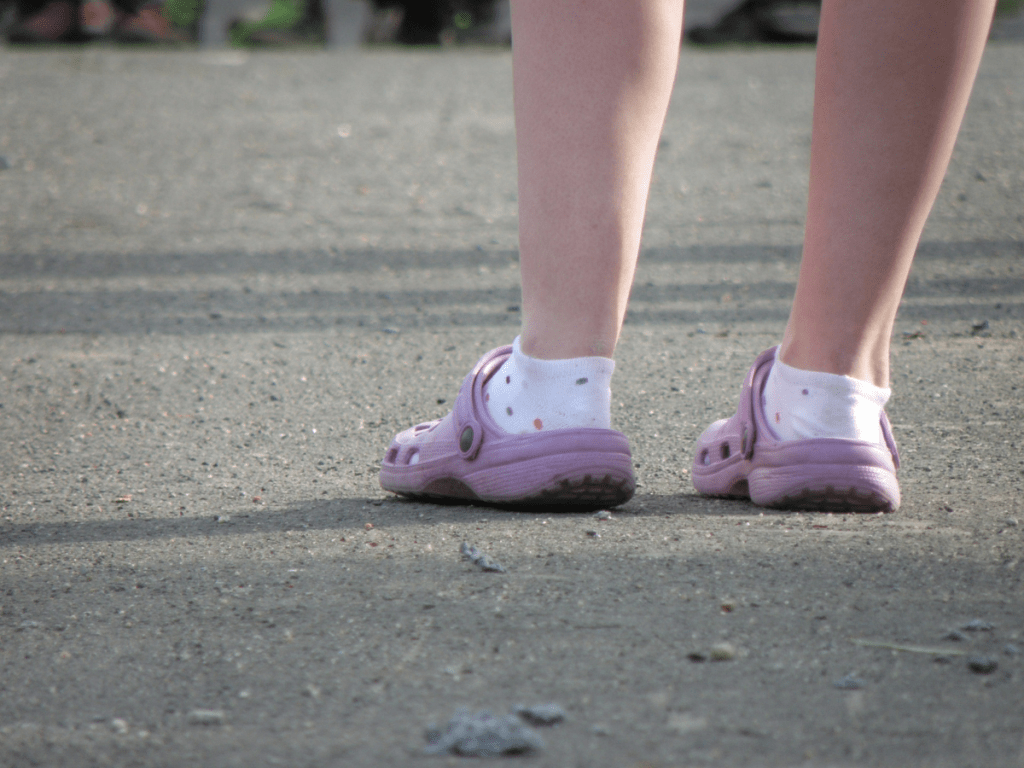
For instance, try putting the strap under your heel instead of behind the shoe. And if you’re prone to blisters, apply moleskin around any spots on your foot that might cause blistering. Trust me, you won’t regret it! And if you feel a blister starting to form, don’t wait – switch to a different pair of shoes right away. Your feet will thank you!
Another option is using an anti-friction balm for foot protection.
Just apply the balm generously to areas prone to blisters, like the top of your feet and below the ankle bones. It lasts up to 6 hours, letting you enjoy the beach or Disney World in Crocs without socks or blister worries.
Are Crocs Good for Plantar Fasciitis?
Did you know that Crocs shoes can help relieve the discomfort caused by plantar fasciitis?
The classic clogs of these shoes have been specially adapted to provide excellent arch support and a breathable footbed, which can be very beneficial for people with plantar fascia pain.
These shoes offer great comfort throughout the year for those struggling with plantar fasciitis. However, it’s important to note that prolonged use of these shoes may lead to the formation of corns, calluses, or ingrown toenails.
If you are looking for shoes with strong arch support, Crocs can be an excellent option, and you can always exchange them if they don’t suit your needs.
What Are The Best Crocs for Hiking?
Trail Crocs
Trail Crocs, also known as Crocs Offroad or Crocs Specialist, is a variation of Crocs footwear specifically designed for outdoor activities, including hiking and trail walking.
While they are an improvement over traditional Crocs for outdoor use, they still have limitations compared to dedicated hiking shoes or boots. Here are some key features of Trail Crocs:
- Traction: Trail Crocs typically feature a rugged outsole with deeper lugs or patterns to provide better traction on various surfaces. The enhanced traction helps improve grip on trails, especially in muddy or slippery conditions. However, the traction may still not match that of dedicated hiking footwear.
- Protection: Trail Crocs often have a closed-toe design, offering some degree of protection compared to the open-toe style of traditional Crocs. The closed toe helps shield your feet from impacts with rocks, roots, or other trail hazards. However, the level of protection provided by Trail Crocs may not be as robust as that of hiking shoes or boots with reinforced toe caps or protective overlays.
- Lightweight and Comfortable: like other Crocs, Trail Crocs prioritize comfort and are typically lightweight. They are made from Croslite foam, which provides cushioning and a soft, comfortable fit.
- Ventilation: Trail Crocs often feature ventilation ports or perforations on the upper to enhance breathability. This design helps to keep your feet cool and reduce moisture buildup, which can be beneficial for longer hikes or in hot weather conditions.
Despite these improvements, Trail Crocs may still have limitations for more demanding hiking scenarios. The support and stability provided by Trail Crocs may not be sufficient for rugged or technical terrains, and their overall durability may not match that of dedicated hiking shoes or boots.
It’s important to consider the specific requirements of your hiking activities and the terrain you’ll be encountering.
Trail Crocs can be a viable option for less demanding and more casual hikes or as a backup pair of shoes, but they may not provide the same level of performance as dedicated hiking footwear.
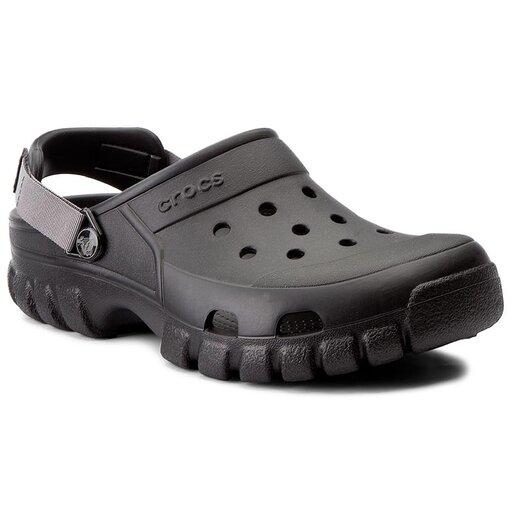
Crocs Hiker Clog [Hiking Clogs]
The classic Hiker Clog are very comfortable, incredibly light, stay on, and they feel pretty solid. The adjustable heel straps help prevent heel slippage and serves for a more secure fit.
They have ventilation ports add breathability, help shed water and debris.
Are they actually be good for hiking?
Some from Reddit is considering Hiker Clog for hiking as well. Especially if the hike is more like a nature walk and there is really hot outside. These shoes also overall do pretty well on flat trails and small hills, or for 1 – 3 mile hikes.
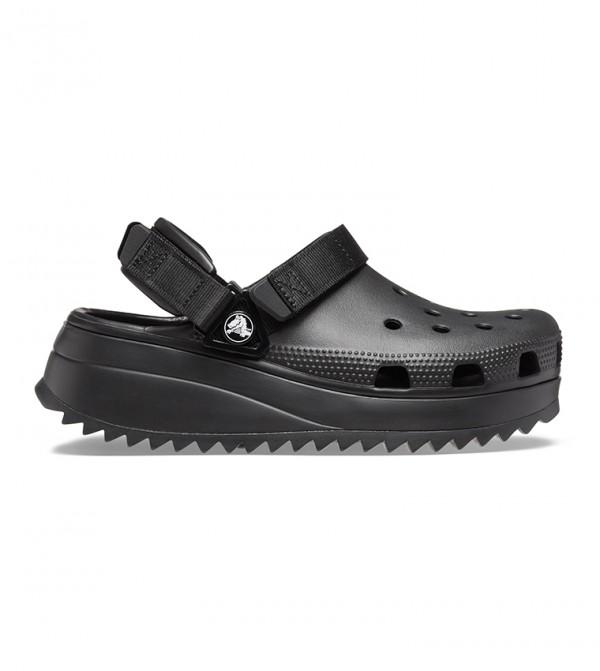
Can You Wear Crocs Barefoot?
Crocs make for good walking shoes, but as for hiking boots, I always wear socks underneath the shoe. The best benefits come with bare feet because the foot breathes and the slippers can slip easily.
You can wear hiking Crocs with an adjustable heel strap. If they start rubbing when you’re barefoot, rotate them away from your feet.
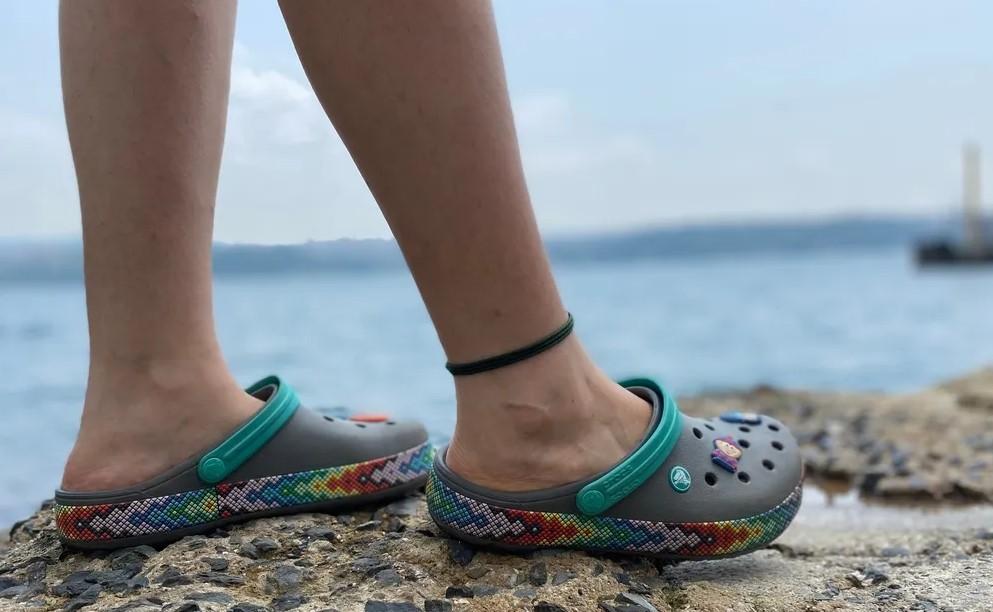
How Much Do Crocs Weigh?
Many hikers wonder how much does a pair of Crocs weigh before considering them as an option for their hiking adventures.
The weight of the classic Crocs Clog can range from 240 grams to 480 grams, depending on the specific shoe. Crocs can reduce bulk in the backpack despite being lightweight.
Are Crocs Good for Creek Walking And River Crossings?
Crocs can be a suitable choice for creek walking and water crossings, as they are waterproof, and dry quickly. Their lightweight design and slip-resistant soles can also provide good traction on slippery rocks and riverbeds.
However, it is important to note that Crocs do not provide the same level of protection and support as dedicated water shoes or hiking boots.
Rocks and other debris in the water crossings can cause injuries to your feet if you don’t have adequate protection.
Also, if the current is strong, or the water is deep, Crocs may not be sturdy enough to provide the stability you need to safely navigate the water.
It’s important to consider the specific conditions of the creek or river you’ll be crossing and to wear appropriate footwear that provides necessary protection and support.
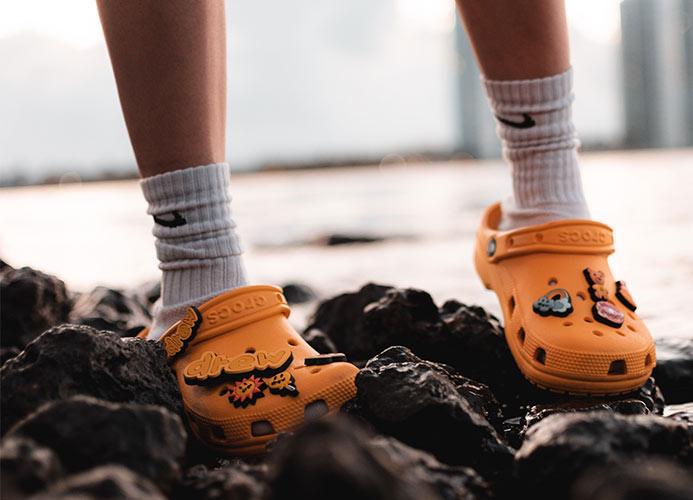
Are Crocs Good for Walking All Day?
Overall, while Crocs can be comfortable and convenient for certain situations, they are not recommended for walking all day.
It’s important to wear proper footwear that provides the necessary support, cushioning, and protection for your feet if you plan to walk for extended periods.
If you have foot problems or concerns, it is important to consult a podiatrist or other medical professional for personalized advice.
Are Crocs Good as Camp Shoes?
Crocs shoes are excellent for a camping trip. They are light and very comfortable. They give the tired feet at camp much comfort.
These are easy to put together using car ties or straps on backpacks or campsites.
They can easily slide out and get off the ground during camping, thanks to the adjustable heel strap they have, making these shoes perfect for bathroom trips in the morning.
Are Crocs Worth it?
The Crocs usually cost $25-42 pounds and can last a lifetime.
Personally, I love Crocs. It’s very comfortable to wear at night after long distance hikes or a full day hike, also are extremely lightweight and affordable.

FAQ
Are Crocs Good for Hiking?
Crocs cleats are very comfortable on your feet and are great for hikes for those with plantar fasciitis. You can wear Crocs as regular hiking shoes for short hikes. If you go hiking long-distance, through the technical terrain, or on less well-maintained trails, you’d prefer hiking footwear if possible.
Crocs for trekking may not be the ideal footwear choice due to their lack of ankle support and durability, which are crucial for hiking in various terrains and conditions.
Can You Wear Crocs on Long Walks?
Depending on how much you spend on the walk, you can wear Crocs because the material is soft. Shoes may look good on your foot, but not have the support needed for walking and standing long. They do not offer foot support, and you might end up feeling pain. When traveling long distances (more than 2 miles), shoes should support the ankle and the arch.
Are Crocs Good for Backpacking
In summary, while Crocs may have some advantages for certain aspects of backpacking, they are not a replacement for proper hiking boots or shoes, especially on challenging terrains. Consider using them as camp shoes or for water crossings in addition to your primary hiking footwear.
Are Crocs Slippery When wet?
Crocs have no extremely deep treads and have an excellent grip on muddy surfaces when new. Crocs are tough, and the real materials from which most Crocs are produced are quite sturdy.
Final thoughts on hiking in Crocs
Hiking in Crocs is not the most common practice, but it is possible, and you can hike in crocs in certain situations.
When hiking in Crocs, it is important to consider the terrain, weather, and duration of the hike.
While Crocs can be lightweight and breathable, they lack the support and protection for a more challenging hiking trail.
If you do decide to go hiking in Crocs, it’s important to take extra precautions and be aware of the risks involved. Hiking in Crocs may be suitable for very short distances and easy hikes on flat terrain, but for more difficult hikes, it is recommended to wear proper hiking shoes for the best support and protection.
Read also about:



![What is considered a long hike? [8 factors to consider] What Is Considered A Long Hike: Top 3 Tips & Best Guide](https://griffithparkhiker.com/wp-content/uploads/2024/01/griffithparkhiker-2-335x220.jpg)




